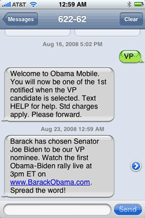President-elect Barack Obama made groundbreaking use of technology to win the 2008 election. Can he now use technology to lead the nation and communicate with the nation’s people in new, life-changing ways? I think so, and I think this foreshadows new ways for Governors, Mayors and other elected officials to lead and communicate.
On November 9th’s ABC program “This Week” (George Stephanopoulos), the discussion turned to our previous major national economic crisis – the Depression. Our current situation has some parallels to that in 1932 – new leadership in a nation facing an economic crisis of frightening dimensions. As we know, the New Deal never really “fixed” the Great Depression – it took World War II to do that. But 1932 is still remarkable for the terrific leadership of Franklin Roosevelt: fresh ideas, a new outlook, and a new way of communicating with people, including Roosevelt’s famous radio “fireside chats”. “This Week’s” commentators mentioned the possibility of “digital fireside chats” from our new President.
Barack Obama, with a tech saavy and skilled team, used the web and Internet to identify and mobilize up to ten million supporters, of whom at least three million financially contributed to the campaign. According to Time Magazine, the campaign raised $150 million in September, 75% of it online (not me, incidentally, I contributed by paper check!).
According to wired-dot-com, volunteers used Obama’s website to organize a thousand phone-banking events in the last week of the race — and 150,000 other campaign-related events over the course of the campaign. The campaign also created myBarackObama.com, essentially a social-networking site with 35,000 affinity groups – the site has some 1.5 million accounts. These social networks were also used to fight many of the false rumors and McCain robo-calls. The campaign even announced Senator Joseph Biden as Obama’s running mate via text message.
Bill Greener, a Republican consultant from Alexandria, quoted in the Seattle Times, said: “We are getting crushed in early voting and the efficient use of technology. It’s a huge deal when the other side is text-messaging to cell phones while our side is hoping we’ve got a good e-mail list.”
One surprising part of that statement is this: a “good e-mail list” is now taken for granted in campaigning – and it falls short! Just three presidential elections ago, e-mailing was an esoteric technology only used by a small fraction of the population.
Researchers at Princeton and the University of Michigan conducted a 2006 study and concluded that a text message delivered by cell phone could boost voter turnout among young people by 4 percent. While that might not sound like much, Obama’s margin of victory was just 6%.
Will the Obama campaign now shut down MyBarackObama.com and take its database of mobile phone numbers, e-mail addresses and supporter names and just put them on a backup tape and send them to Iron Mountain for storage until the next campaign? I doubt it! More likely they will be used to communicate the new President’s message on programs and change, and turn out those supporters to lobby on behalf of legislation.
The “new” web, web 2.0, abounds with tools for communication and collaboration: not just text messaging, but blogging and social networking, YouTube channels and wiki’s. A vast variety of ways for a new, tech saavy, President to engage the people of the United States, and allow us to engage him with our ideas and energy.
Invariably eyes will turn to the 20% to 40% of the population who do not actively use technology or have Internet connections – the “digital divide”. Those without access to technology are, disproportionately, lower income and non-white. Bridging that divide has been a major effort at the City of Seattle and in many other governments.
Now, with a national leader who embraces high tech, it will become “cool” for everyone to use tech and have access. (We call this “Leadership by Example”). Cultural barriers to using technology will fall, and programs to bring it to everyone (such as Seattle’s Community Technology and Broadband work) will gain even more momentum.
Then perhaps we – the People – can become active participants in government, not just observers between elections.
All these are great ideas for a digital fireside chat – and a two-way one – via the electronic fireplace of the computer monitor.




Bill, it so easy to get caught up in the excitement of the Restoration and having a President who looks good in a bathing suit, its easy to lose sight of what is right in front of our eyes.
Barack Obama used technology to leverage and extend, as a force multiplier, the conventional activities of democracy like coffees, speeches, appearances, press conferences, BBQs, debates and other things. He did not use technology to avoid meetings with the public and to escape responsibility, as our Mayor and Council has done and as ‘W’ did. There is a distinct difference between the way Obama used technology… to extend the power of an already powerful man and message… and so many local politicians who want to use YouTube, the Seattle Channel, email newsletters, and streamed announcements to avoid accountability, press questioning, public hearings, and basic democratic participation.
Mike Weisman